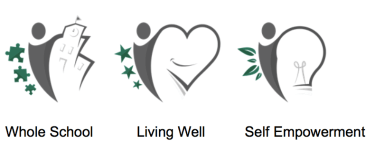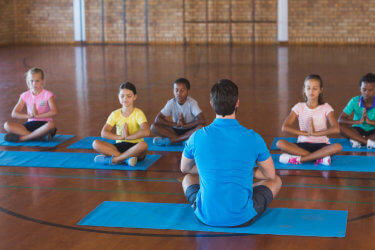Health and well-being are central to the mission of public education, and a healthy school environment is shown to improve academic performance (Birch & Videto, 2015). At Slippery Rock University, our goal is to prepare school wellness educators who are certified in K-12 health and physical education and serve as key players in creating a healthy and vibrant school. Our teacher education curriculum is based on the Whole School, Whole Community, Whole Child (WSCC) model, and candidates are prepared to view the entire school as their area of influence. In this article, we’ll explain (1) why we created a new teacher education program, (2) the School Wellness Education program’s alignment with 50 Million Strong, (3) how we encourage teacher candidates to think differently about their role in schools, and (4) how we created a culture of wellness in the Physical and Health Education Department at Slippery Rock University.

Why We Created a New Teacher Education Program
Our inspiration to design a new program started when enrollment in the teacher education program was low. Action needed to be taken to sustain the program and to increase the recruitment and retention of high-quality students into the health and physical education professions. Based on low enrollment data, faculty within the Physical and Health Education Department scheduled a series of meetings to begin the process of designing a new program. Faculty wanted to create something new and relevant that would attract more students, but most importantly, something that society needed and would value.
The importance of creating something that society needed was influenced by a series of books, including Start With Why by Simon Sinek (2009), Good to Great by Jim Collins (2001), and No Sweat: How the Simple Science of Motivation can Bring You a Lifetime of Fitness by Michelle Segar (2015). According to Sinek, what separates great leaders and great companies from the rest is that they start by asking “why?” Before designing courses for the school wellness education curriculum, we made a point to begin each discussion with “why?” Our “why” became to create a healthier and more physically active society through schools. Public health and school health data suggests that this is something our society needs (Birch & Videto, 2015).

After identifying our “why” as a teacher education program, we developed the new School Wellness Education (SWE) curriculum. The SWE curriculum prepares professionals in health, physical activity, and school wellness while earning K-12 teaching certification in health and physical education. The curriculum is based on five pillars. Teacher candidates develop skills in teaching excellence, physical health and wellness, school-to-community health and wellness, social, emotional, and cognitive wellness, and professionalism, advocacy, and leadership. Consistent with the Whole Child Model (WSCC), program graduates are prepared to lead comprehensive school physical activity programs and other wellness programming in schools (Brewer, Nichols, Leight, & Clark, 2017). Our accredited teacher education curriculum is nationally recognized and is based on current initiatives through the Centers for Disease Control and Prevention, Active Schools, and SHAPE America.
School Wellness Education Program’s Alignment with 50 Million Strong by 2029
Achieving 50 Million Strong by 2029 starts with the teacher, and we believe that teacher preparation programs are largely responsible for the quality of health and physical education programs in k-12 schools. In this section, we discuss how the SWE curriculum at Slippery Rock University prepares teachers with the skills, experiences, and resources necessary to create a learning community in schools that empowers students to live healthy and active lives.

In the School Wellness Education program, teacher candidates first take a course titled “Foundations of School Wellness.” In this course, candidates learn about the SHAPE America Standards and Grade Level Outcomes, Comprehensive School Physical Activity Programs (CSPAP), and the Whole School, Whole Community, Whole Child (WSCC) Model. This course sets the stage for the remainder of the School Wellness Education program. In the first year of the program, candidates engage in an experiential field component where they are transported to local schools to observe quality teaching and CSPAPs in action. Courses throughout the four-year curriculum further enhance candidates knowledge and skills in the areas of WSCC and CSPAP, while developing effective teaching strategies in health and physical education. Shown below are the required classes for the School Wellness Education majors in our recommended four year plan.
Slippery Rock University School Wellness Education: Recommended Four Year Plan
| Semester 1 | Credits | Semester 2 | Credits |
| Aquatic Fundamentals | 3 | Principles of School Wellness I | 3 |
| Foundations of School Wellness | 3 | Introduction to Adapted Physical Activity | 3 |
| Semester 3 | Semester 4 | ||
| Technology for Wellness
|
3 | Educational Movement in Health/Wellness | 3 |
| Contemporary Topics in Health | 3 | Social and Emotional Wellness | 3 |
| Motor Development | 3 | Anatomy and Physiology of Physical Activity | 3 |
| Semester 5 | Semester 6 | ||
| Elementary Skills and Fitness Activities | 3 | Middle School Skills and Fitness Activities | 3 |
| School Nutrition | 3 | Secondary Skills and Fitness Activities | 3 |
| Principles of School Wellness II | 3 | Elementary School Wellness Strategies in the Field | 3 |
| Outdoor Pursuits | 3 | ||
| Semester 7 | Semester 8 | ||
| Secondary School Wellness Strategies in the Field | 6 | Student Teaching | 12 |
| School Wellness Assessment and Promotion | 3 | ||
| Professionalism, Advocacy, and Leadership | 3 |
Through this curriculum, all of the fitness skills and sports skills that are included in the SHAPE America Standards and Grade Level Outcomes are included in the three teaching strategy courses (1) Elementary Skills and Fitness Activities, (2) Middle School Skills and Fitness Activities, and (3) Secondary Skills and Fitness Activities. Courses based on one sport such as “Teaching Basketball” or “Teaching Territory Games” are no longer included as stand-alone courses in the curriculum. Removing single-topic sport-based courses opened up space for new courses that relate directly to the Whole Child Model (WSCC). Social and Emotional Wellness is one of the new courses. This prepares teacher candidates to initiate and lead programs throughout the whole school that improve students’ social and emotional well-being. Nutrition for School Wellness is another new course that not only prepares candidates to teach k-12 nutrition, but also to serve as advocates in creating a healthy nutrition environment throughout the whole school.

Encouraging Teacher Candidates to Think Differently About Their Role in Schools
Perhaps even more important than the new courses in the SWE curriculum is the mindset we are aspiring to create within each and every teacher candidate. Throughout all of the undergraduate courses, teacher candidates are first encouraged to get out of the health and physical education silos where learning only takes place in the gymnasium or health classroom and view their area of influence as the whole school. Within our program, we refer to this way of thinking as “Whole School.”Second, teacher candidates are encouraged to think about why each physical activity or lesson they teach is relevant to students’ lives, and how it enhances students’ overall health and well-being. Within our program, we refer to this as “Living Well.” Third, teacher candidates are encouraged to provide opportunities for students to reflect, make connections to their own lives, and become empowered to live healthy and active lives. Within our program, we refer to this as “Self-Empowerment.” Each teacher candidate is prepared to create k-12 health and physical education lessons that relate to (1) the whole school, (2) Living Well (SHAPE America Standards), and (3) Self-Empowerment. The following icons represent these three key aspects of School Wellness Education. This is what makes school wellness education different from traditional health and physical education.

Healthy School Environment
Beyond preparing quality teachers who empower students to live healthy and active lives, for 50 Million Strong by 2029 to succeed, it must be supported throughout the whole school and community. In the past, the responsibility of health and physical education has fallen on individual teachers with little or no connection to the whole school (Gleddie & Robinson, 2017). Placing an increased emphasis on the health and vitality of all individuals in schools (students, teachers of all disciplines, and staff) allows students to take the skills and concepts learned in their physical and health education classes and apply these health-enhancing behaviors during the rest of the school, at home, and in their community. The application of these skills outside of the walls of the gymnasium or health classroom help empower youth to sustain healthy behaviors for a lifetime.
Infusing vitality into a school starts by eliminating items that do not project health, happiness, or positivity. This could include, but is not limited to: Clutter, outdated materials, unhealthy food options, routines that promote sedentary behaviors, bulletin boards that are not well kept, and old trophies or banners in the gymnasium that speak only to athletes, not to the whole school community. There are many different ways to intentionally create a culture of wellness in schools, and we recommend starting with one thing.

Choosing one area of school wellness to focus on will plant a seed for wellness to grow within your school community. After planting this seed, it is important to encourage others within your school community to also begin planting their own school wellness seeds. Here’s a sampling of some changes, both large and small that can have significantly impact employee and student wellness:
- Provide opportunities for individuals to pursue additional physical activity
- Physical activity equipment that can be signed out after school or on weekends (by students, faculty, and staff)
- Digital devices made available for personally tracking physical activity (optional, not mandatory to use)
- Student organizations that promote physical activity and healthy lifestyles throughout the school day (wellness club, mindfulness through movement course, etc.).
- Collaboration between the school and community to promote participation in physical activity in the community (marathon relay teams, after school table tennis or racquetball clubs, 5k walk/runs, group cycling rides at a local trail, etc.).
- Provide opportunities for physical activity throughout the school day
- Morning walking clubs.
- Opportunities for students to practice skills learned in physical education later in the school day, after school, or in the community.
- Yoga/stretching/physical activity for all during the morning or mid-day announcements.
- Faculty/staff wellness room or fitness center.
- Brain boost room for students that includes opportunities for physical activity.
- Standing desks or stability ball chairs.
- Brain boosts routinely implemented in the classroom for students and staff.
- A 2-3 minute walk where everyone walks – just to walk – between classes.
- Create a clean, spacious, green environment
- Comfortable places for students to socialize and study.
- Green plants.
- Positive messages throughout the building.
- Elimination of negative or sarcastic messages (sometimes these are not portrayed to the “whole school” but students may see them on individual teacher’s desks).
- Increase access to health-enhancing foods
- A bowl of fresh fruit available to faculty, and staff (apples, oranges, bananas, etc.) Healthy foods available to students as well. This may include a healthy grab and go breakfast or snack.
- A community garden that allows anyone in the school community to trim lettuce, herbs, or take a sugar snap pea as a mid-day snack. This can be accomplished through creating a Tower Garden, an outdoor garden, a pallet garden, a windowsill garden, or other garden space.
- Information about non-food rewards or healthy alternatives to unhealthy food choices.
- A student advocacy group that advocates for nutritious foods in the cafeteria and on-campus. This group would help decide what foods should or should not be served in school, during after school activities, or sold during fundraisers. The student advocacy group could present their recommendations to Food Services, school administration, and the district wellness committee.
- Water: access to water throughout the school day for all students.
- Make health the norm
- Organize a district wellness committee and building level wellness teams. A dedicated team of teachers, students, and staff at each building who meet regularly and pay attention to school wellness (identifying additional needs for school wellness, analyzing current initiatives that are working or not working, etc.)
- Teachers, staff, and administrators who model healthy lifestyles
- Recognize students, staff, and faculty who are doing a good job personally pursuing a healthy lifestyle and/or are helping to inspire others to be healthy (public recognition when people are doing a good job and making a difference in promoting school wellness)
- Offer professional development for teachers, administrators, and staff in the areas of school wellness (Hargreaves & Fink, 2006; Gleddie & Robinson, 2017).
These are just some of the strategies for creating a healthier and more vibrant school community. It all starts with the teacher and the school environment. For 50 Million Strong by 2029 to be sustainable, students must not only be given the knowledge and skills of how to live a healthy, active life, but also be raised in a school environment that supports and is 100% committed to promoting healthy, active lives for everyone.

“When a flower doesn’t bloom, you fix the environment in which it grows, not the flower”
– Vibrant mind
This quote holds true for student wellness. Changing the environment is often far more effective than trying to change individual behavior (Putnam, 2015).
The Slippery Rock University Experience
Since creating the new school wellness education program and creating a healthier culture within the Physical and Health Education Department at Slippery Rock University, we’ve seen a positive impact on both the faculty and our teacher candidates. Teacher candidates are empowered to not only lead healthy, active lives for themselves, but also to advocate for physical education, physical activity, and wellness in schools. We’re working to achieve 50 Million Strong by 2029 by creating teachers who view their area of influence as the entire school so that the skills learned in physical and health education can be “lived out” throughout the entire school and community.
References
Birch, D. A., & Videto, D. M. (Eds.) (2015). Promoting health and academic success: The whole school, whole community, whole child approach.Champaign, IL: Human Kinetics.
Brewer, H. J., Nichols, R., Leight, J. M., & Clark, G. E. (2017). Preparing Physical and Health Education Teacher Candidates to Create a Culture of Wellness in Schools: New Curriculum, New Message. JOPERD: The Journal Of Physical Education, Recreation & Dance, 88(9), 14-20.
Collins, J. C. (2001). Good to great: Why some companies make the leap and others don’t. New York, NY: Harper Business.
Gleddie, D. L., & Robinson, D. B. (2017). Creating a healthy school community? Consider critical elements of educational change. JOPERD, 88(4), 22-25.
Hargreaves, A., & Fink, D. (2006). The ripple effect. Educational Leadership, 63(8), 16-20.
Putnam, L. (2015). Workplace wellness that works: 10 steps to infuse well-being and vitality into any organization.Wiley and Sons, Hoboken NJ.
Segar, M. (2015). No Sweat: How the Simple Science of Motivation Can Bring You a Lifetime of Fitness. AMACOM, New York, NY.
Sinek, S. (2009). Start with why: How great leaders inspire everyone to take action. New York, NY: Portfolio.
